Markets broadened as we anticipated, and our Decathlon strategies were able to take advantage
With Central Banks around the world lowering their policy interest rates, the third quarter saw a broad-based rally in all asset-classes and geographies with the strongest performance taking place in previously lagging categories, like small capitalization and value stocks, emerging markets (especially China), and all types and maturities of bonds.
Our strategies performed well in the quarter. We rotated from the market leading technology sectors into the laggard small-capitalization and value categories shortly before the herd and rode the trend for the majority of the rally.
We are entering this quarter with the signal to tap the brakes a bit
After the strong rally, our investment systems are currently advising a reduction in risk-appetite. As a result, we recently positioned our portfolios more cautiously, lowering our equity exposure by 10% in our more aggressive models. For the near term, our models favor a significantly narrower selection of equity categories than three months ago, with the most attractive ETFs being in the financial services, healthcare (biotech), and electrical/ industrial sectors as well as India. Bonds of all categories are ranked highly, offering a modest incremental return if we have a market pause, and possibly, significant protection and relative performance if there is an adverse geopolitical event or market correction.
The third quarter became a story of China and the Federal Reserve (Fed)
Despite titling our last quarterly letter “Betting on a Broadening”, we never could have anticipated the near perfect reversal of market leadership we saw just days later at the onset of the third quarter. While the kindling was in place, it was Jerome Powell’s July speech, all but assuring imminent rate cuts, that provided the spark. Value outperformed growth, small caps outperformed large, and international outperformed domestic stocks[1]. This was a welcome reprieve against what had become a historically concentrated equity market. After China’s recent surge it is now amazingly far and away the best performing equity market on the year.
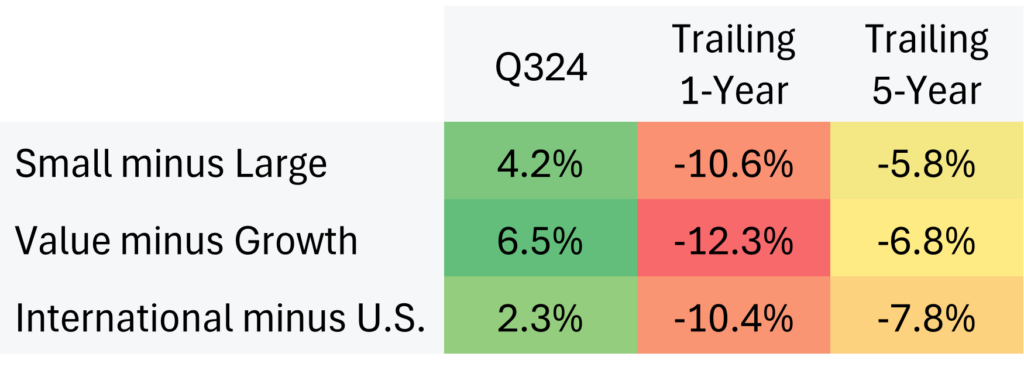
Source: Bloomberg data 9/30/2019 through 9/30/2024. “Small caps” is referencing the S&P 600 Index; “Large cap” is referencing the S&P 500 Index; “Value” is referencing the CRSP US Large Cap Value Index; “Growth” is referencing CRSP US Large Cap Growth Index; U.S. is referencing S&P 500 Index; and International” is referencing MSCI All-Country World Ex-US Index
The reversal in leadership did not come at the cost of weak performance for the prior leaders as nearly all assets did well in the quarter, driven by an expectation of better odds for a “soft landing” scenario. Economic growth and employment were weaker, but not too weak, while inflation has been subdued for some time. We suggested that a broadening would be welcome for our strategies, and it was, as performance amongst our higher risk models was particularly strong. This quarter, the equities in our investment pool provided a tailwind to our performance as the average equity outperformed market cap indices. Most of our best performing picks were within the financial sector, a sector whose fate is inextricably linked to economic health and interest rate policy. Energy provided the lone material performance detractor for the higher risk models, while a general lack of fixed income duration, and the usage of alternatives, impacted the conservative model versus its target benchmark.
We expect investors to continue to shift their focus from inflation to growth
At the beginning of the year, we stated that we believed investors’ focus would shift from inflation to growth. Now that Fed policy has shifted, we expect this shift to continue into 2025. While we believe the Fed could have lowered rates sooner, we are much more comfortable with the Fed’s narrative around interest rate policy after the last meeting. It is obvious that, on the margin, they are more focused on the risks to growth than inflation. It remains to be seen if the effects of higher rates will ultimately continue to cause pain on a lag or whether rate cuts will provide an immediate improvement in interest sensitive areas such as housing and autos which have had their demand substantially curtailed.
As the market has moved considerably towards the prospect of a soft landing, we don’t see a compelling risk/reward for substantial equity risk. We believe, however, that intra-sector dispersion will increase since the economy going forward is likely to be very different from the one of the past few years, potentially creating new relative winners and losers.
While large-cap companies (particularly the very largest) have been able to navigate higher inflation with relative ease, the impact on smaller companies has been far more pronounced. Analogous to how top quintile households had an easier time absorbing inflation than bottom quintile. With inflation now in the rearview mirror, it’s possible a larger array of companies stands to benefit from a more predictable price environment.
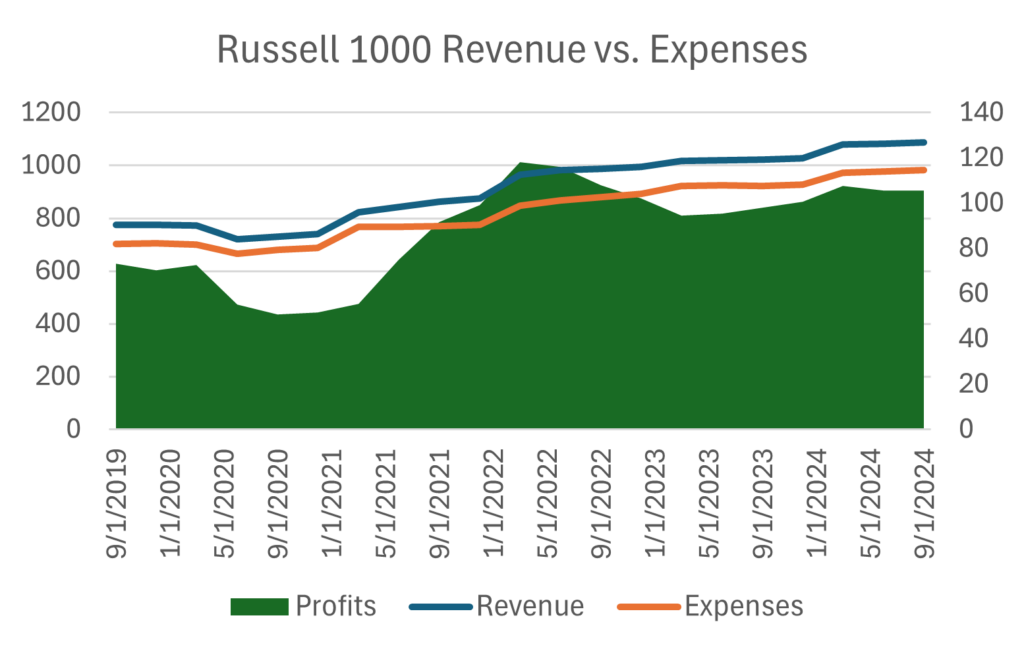
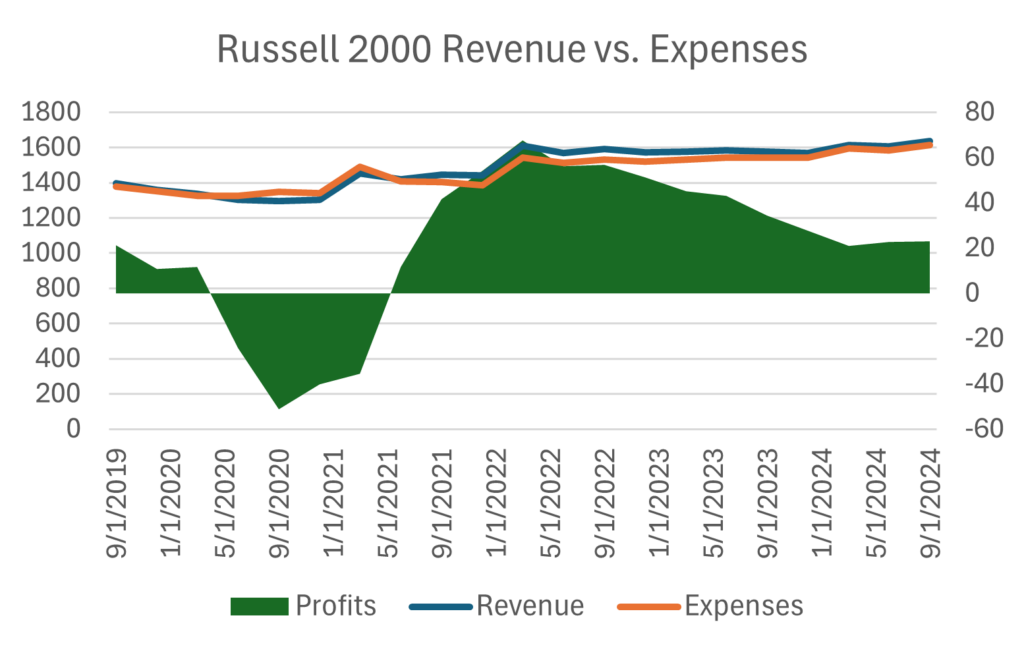
Source: Bloomberg, Russell 1000 and 2000 indices for 5-year period 9/30/2019 through 9/30/2024
Negatives:
* Equities have run ahead of fundamentals: Investors have made large gains in a short time in many asset categories without having to wait for the underlying companies or economic facts to deliver.
Stocks prices have increased despite near-term earnings expectations decreasing, with investors pushing out improvements into the less predictable future.
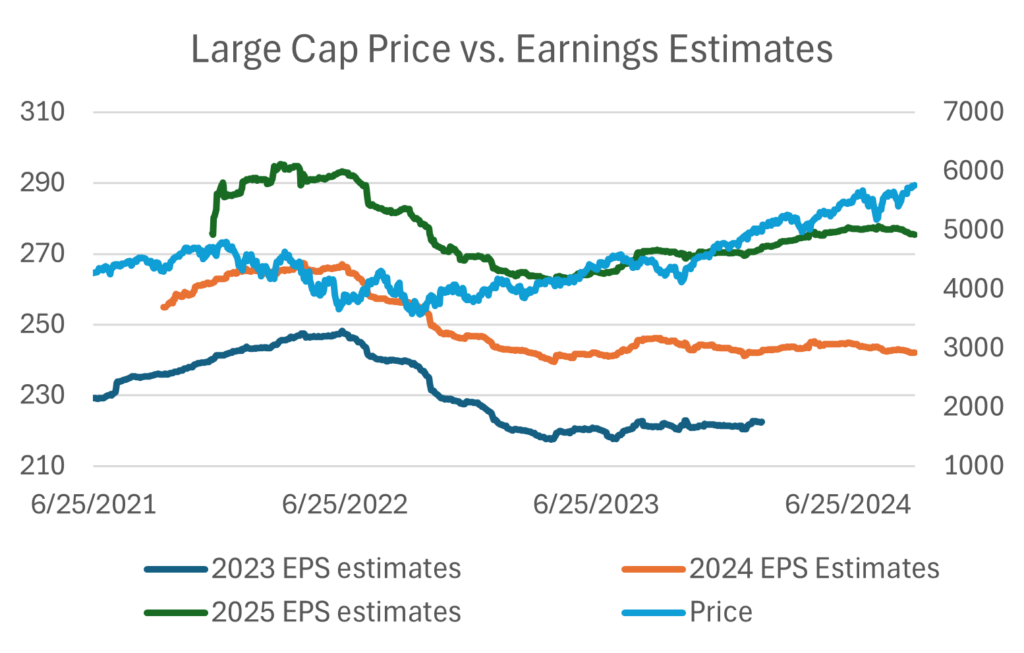
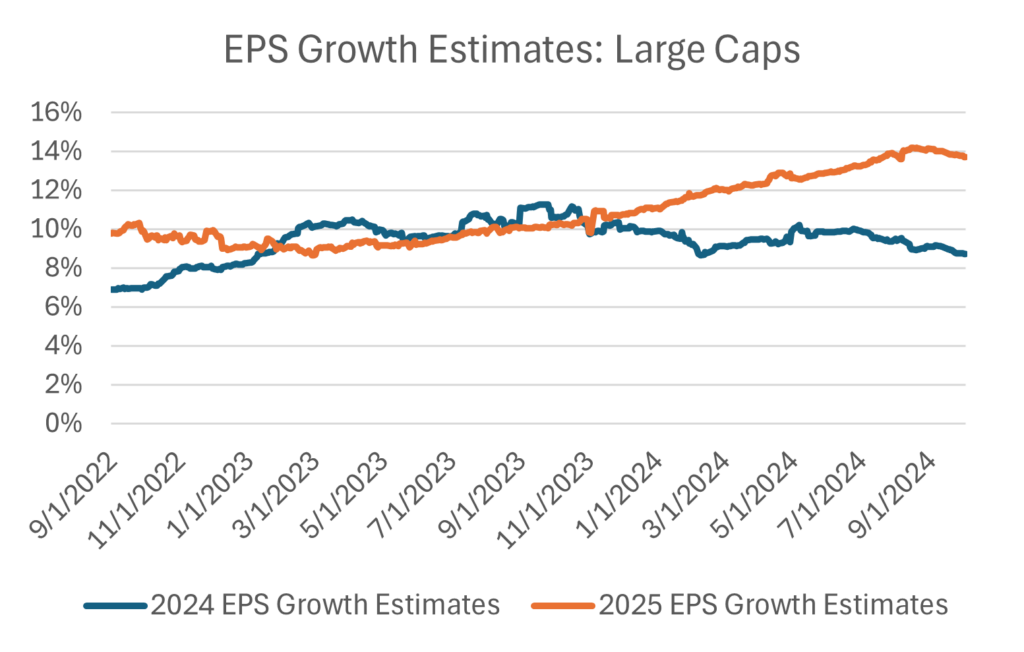
Source: Bloomberg, earnings estimates from 9/30/2021 through 9/3/2024, large cap index is the S&P 500
This is even more acute for smaller-cap companies, posing a risk to the broadening thesis.
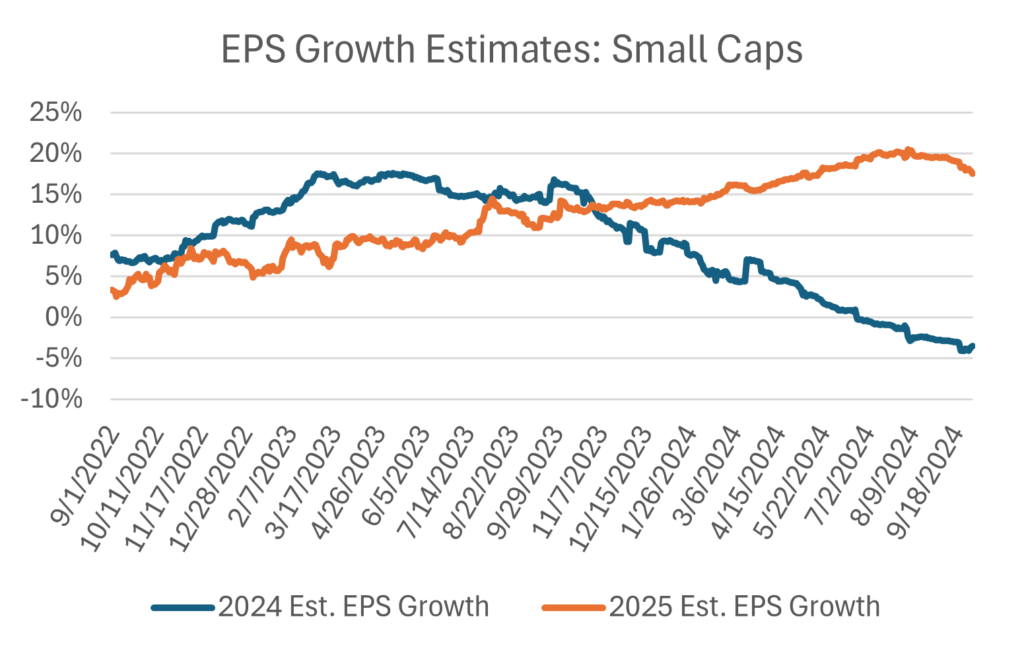
Source: Bloomberg, earnings estimates from 9/30/2021 through 9/3/2024, small cap index is the S&P 600
* High Valuations: The entire S&P 500 trades for 23.8x 2024 earnings[2], but multiples for the highest quality companies are even higher. The largest, Apple, sports a P/E of 34.7[3], among the highest in the companies’ own history.
* Economic fatigue. Hiring is slowing. Both consumer credit and auto loan delinquencies are on the rise. There’s been a noticeable weakening of the low-end consumer.
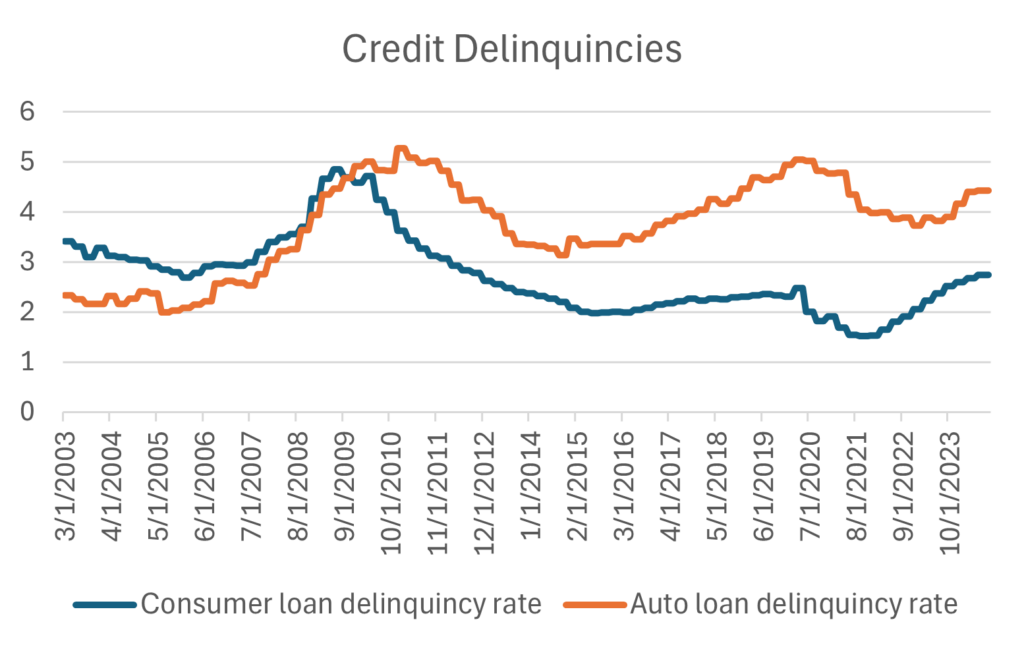
Source: Bloomberg data for 3/31/2003 through 9/30/2024, for all consumer loans and auto loans.
* On-going political uncertainty ahead of U.S. Elections.
* U.S. Government finances continue to appear unsustainable. In rough per-person terms, at a $1.6 trillion annual deficit, the government is spending $400 per month more than it is collecting in taxes. Neither presidential candidate appears willing to tackle this issue as the prospective options all require near-term economic pain.
* Geopolitical tensions remain extraordinary: Russia/Ukraine, Israel/Hamas (increasingly Israel/Hamas/Hezbollah/Iran), US economic restrictions on commerce with China.
* Possible contagion in organized labor strikes resulting in economic disruption and broad wage and generalized inflation. Wages are now firmly ahead of overall inflation which is good for aggregate consumers but may also create future inflation if it persists.
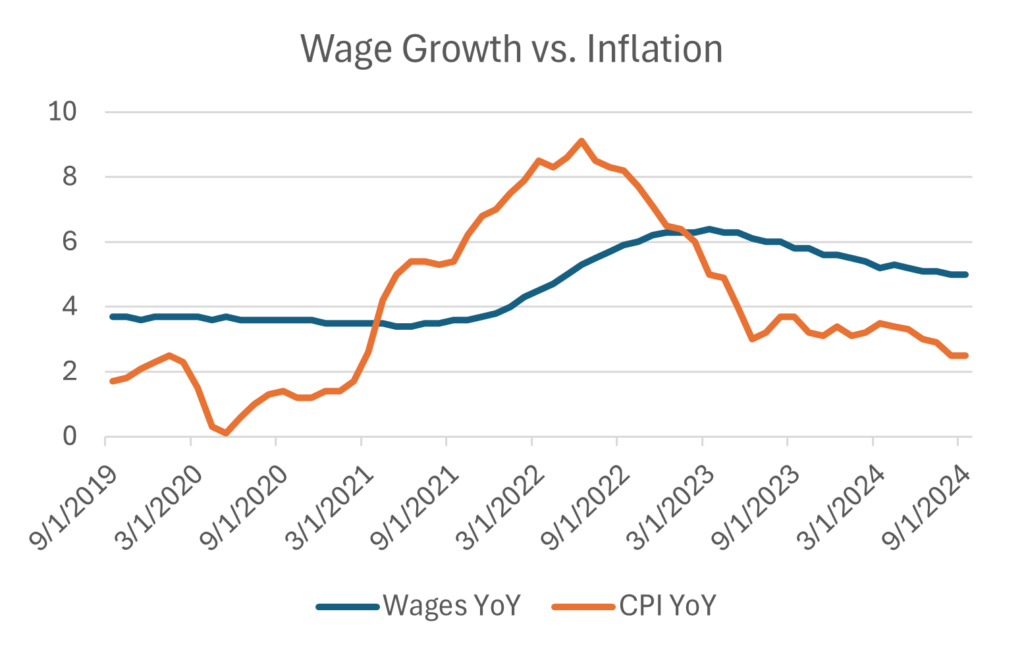
Source: Bloomberg data for 5-year period 9/30/2019 through 9/30/2024, wage growth derived from Atlanta Fed wage tracker and CPI is US CPI for urban consumers.
Positives:
* Wealth Effect: Household wealth is increasing significantly with equity markets and house prices at all-time highs and bond prices largely recovered.
* Future monetary policy looks more predictable. At current interest levels, retirees can earn a meaningful return on their savings. So middle- and upper-class households are in great economic shape. If the Federal Reserve lowers interest rates as projected, lower income families will have a tail wind as well.
* Earnings from market leading companies have been great. There seems to be a new cost-conscious mindset across companies of all sizes, resulting in margin improvement and highly profitable growth. The application of new AI technologies to improve productivity may accelerate the trend.
* Return of the Chinese growth engine. China’s late quarter market surge was driven by its relatively unprecedented stimulus plans. Thus far the Chinese economy has been a drag on global growth, albeit also potentially detracting from inflation. Should these measures help restore consumer confidence, which has been deeply shaken from the country’s weak housing market, China could be a very large contributor to Global growth.
Concluding thoughts
Despite our own lukewarm outlook, we believe our tactical strategies are poised to capitalize on any change to the prevailing market narrative. Our strategies’ strong trailing one-year performance, despite a narrow market environment for much of the period, gives us confidence that we are well-positioned to benefit disproportionately if the market broadening observed this quarter marks the start of a longer-term trend aligned with the new interest rate (cutting) cycle. The average investor’s portfolio, through inertia alone, is likely anchored heavily to recent winners, offering a unique opportunity to increase exposure to more tactical strategies or those that favor some overlooked sectors should the trend of a broader market continue.
[1] Bloomberg data 9/30/2019 through 9/30/2024. “Small caps” is referencing the S&P 600 Index; “Large cap” is referencing the S&P 500 Index; “Value” is referencing the CRSP US Large Cap Value Index; “Growth” is referencing CRSP US Large Cap Growth Index; U.S. is referencing S&P 500 Index; and International” is referencing MSCI All-Country World Ex-US Index
[2] Bloomberg data through 9/30/2024 – $5672 price and $242 in estimated earnings
[3] Bloomberg data through 9/30/2024 – $233 price and $6.7 in estimated earnings









